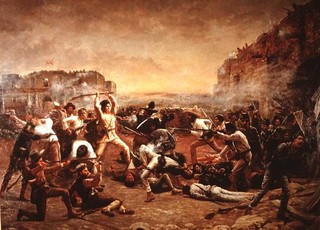Moses Rose: A Tale of the Alamo and Survivors

This novel is fiction based on a legend. When first published in 1996, Moses Rose: A Tale of the Alamo and Survivors was called “intriguing” by The Dallas Morning News, an “imaginative tale in which Rose must deal with many different meanings of heroism, survival, loneliness, and love.”
Even now, some 180 years after the fall of the Alamo on March 6, 1836, scholars, Alamo buffs, and Texans in general continue to debate whether Louis Rose actually existed -- and if he did, whether he stayed at the Alamo to martyr himself, or whether he was the only defender to decide to leave when given the chance. For example, the Robert James Onderdonk painting is popularly known for imagining Davy Crockett fighting at the Alamo -- but there is still debate or whether he died in this way, or was among a group of defenders who surrendered, and were then executed.
This work of historical fiction imagines a life for Louis Rose, called “Moses” by other Alamo defenders because as one of the oldest men in the fortress, he was a veteran of Napoleon’s Grand Army and its disastrous invasion of Russia in 1812. He has experienced both the glories and the horrors of Napoleon’s conquests.
But many years later, in March 1836, Moses finds himself among about 180 men trapped in the Alamo by several thousand Mexican soldiers surrounding them, soldiers who often hear el deguello: no mercy will be given to the defenders. Moses chooses to leave knowing the consequences of his fateful decision will mean he will face a life trying to cope with hatred, suspicion, and attempts to kill him, all because of his decision.
He does not know that he is destined to meet Mary Kimbro.
Mary’s husband, George, chose to accept a certain death at the Alamo, leaving behind Mary and their hopes for a long life on the Texas frontier, as well as their wishes for a large family to help create an expanding America.
She is embittered, and survives only with the emotional and physical protection of her friends, freed slaves Martha and Elvin. But when she hears rumors of a man who might have been at the Alamo with George, and who chose to leave rather than die, she embarks on a question to not only learn about George’s decision to stay, but also to confront Moses as the coward he might be.
Louis and Mary travel separate paths during the months after the fall of the Alamo, each enduring physical dangers and moral crises during the rain-and-mud soaked Runaway Scrape that flooded much of frontier Texas in the Spring of 1836. But their paths eventually meet, and both Louis and Mary will be profoundly changed – by deaths that continue to strike the pioneers struggling to create a new Republic of Texas; by attempts to kill Moses; by the individual memories of Moses and Mary; by the memories they begin to create together; and by their searches for redemption, for love, and for the future.
William Rainbolt, who holds a Ph.D in History, bases Moses Rose on extensive research, including visits to many of the pioneer Texas sites used for scenes.
In 2016 Goose River Press in conjunction with First Edition Design Publishing issued a slightly revised twenty anniversary ebook edition, available at Amazon Kindle, Barnes & Noble Nook, Kobo, and other online publishers.
Moses Rose: A Tale of the Alamo and Survivors (eBook), First Edition Design Publishing, 2016; org. pub. 1996, Dan River Press (Thomaston, ME). Twentieth Anniversary edition.